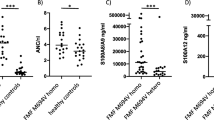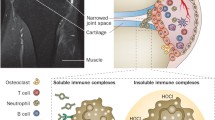Abstract
Familial Mediterranean Fever is a disorder of unknown cause characterized by recurrent, self-limited paroxysms of serosal inflammation. Although the neutrophil is the predominant cell involved, no cellular abnormalities are known. Chemiluminescence was studied in neutrophils from 20 asymptomatic patients with this disease and 21 healthy controls to evaluate the oxidative response to formyl-methionyl-leucyl-phenylalanine (f-met-leu-phe). In a subset of patients with familial Mediterranean fever, neutrophils but not monocytes were shown to have significantly enhanced chemiluminescence compared to controls. The enhanced responsiveness of neutrophils to f-met-leu-phe in this disease was found to occur at a postreceptor level. Receptor binding assays demonstrated no differences in binding affinity and receptor number between patients and controls. In addition, a similar enhancement in chemiluminescence was observed with an alternative stimulus (zymosan). In contrast to chemiluminescence, chemotaxis induced by f-met-leu-phe was not enhanced in patients with familial Mediterranean fever. The enhanced neutrophil chemiluminescence may identify a subclinical inflammatory state in attack-free patients with familial Mediterranean fever, as enhanced chemiluminescence is also observed in chronic inflammatory diseases with active inflammation.
Similar content being viewed by others
References
Siegal, S: Benign paroxysmal peritonitis. Ann Intern Med 23:1–21, 1945
Heller H, Sohar E, Sherf L: Familial Mediterranean fever. Arch Intern Med 102:50–71, 1958
Schwabe AD, Peters RS: Familial fever in Armenians, Analysis of 100 cases. Medicine 53:453–462, 1974
Sohar E, Pras M, Heller J, Heller H: Genetics of familial Mediterranean fever (FMF): A disorder with recessive inheritance in non-Ashkenazi Jews and Armenians. Arch Intern Med 107:529–538, 1961
Schlesinger M, Ilfeld DN, Zamir R, Brautbar C: Familial Mediterranean fever: No linkage with HLA. Tissue Antigens 24:65–66, 1984
Goldstein RC, Schwabe AD: Prophylactic colchicine therapy in familial Mediterranean fever. A controlled double-blind study. Ann Intern Med 81:792–794, 1974
Zemer D, Revach M, Pras M, Modan B, Schor S, Sohar E, Gafni J: A controlled trial of colchicine in preventing attacks of familial Mediterranean fever. N Engl J Med 291:932–934, 1974
Dinarello CA, Wolff SM, Goldfinger SE, Dale DC, Alling DW: Colchicine therapy for familial Mediterranean fever. A double-blind trial. N Engl J Med 291:934–937, 1974
Eliakim M, Levy M, Ehrenfeld M: Recurrent Polyserositis (Familial Mediterranean Fever, Periodic Disease). Amsterdam, Elsevier/North-Holland, 1981
Matzner Y, Partridge REH, Levy M, Babior BM: Diminished activity of a chemotactic inhibitor in synovial fluids from patients with familial Mediterranean fever. Blood 673:629–633, 1984
Matzner Y, Brzezinski A: C5a-inhibitor deficiency in peritoneal fluids from patients with familial Mediterranean fever. N Engl J Med 311:287–290, 1984
Schwabe AD, Lehman TJA: C5a-inhibitor deficiency—A role in familial Mediterranean fever? N Engl J Med 311:325–326, 1984
Siegal S: Familial paroxysmal peritonitis. Analysis of fifty cases. Am J Med 36:893–918, 1964
Brick IB, Cajigas M, Benign paroxysmal peritonitis: Surgical and histological findings. N Engl J Med 244:786–790, 1951
Reimann HA, Moadie J, Semerdjian S, Sahyoun PF: Periodic peritonitis-heredity and pathology. Report of 72 cases. JAMA 154:1254–1259, 1954
Dinarello CA, Chusid MJ, Fauci AS, Gallin JS, Dale DC, Wolff SM: Effect of prophylactic colchicine therapy on leukocyte function in patients with familial Mediterranean fever. Arth Rheum 19:618–622, 1976
Territo MC, Peters RS, Cline MJ: Leukocyte function in familial Mediterranean fever. Am J Hematol 1:307–311, 1976
Schwabe AD, Terasaki PI, Barnett EV, Territo MC, Klinenberg JR, Peters RS: Familial Mediterranean fever. Recent advances in pathogenesis and management. (specialty conference). West J Med 127:15–23, 1977
Bar-Eli M, Wilson L, Peters RS, Schwabe AD, Territo MC: Microtubules in PMNs from patients with familial Mediterranean fever. Am J Med Sci 284:2–7, 1982
Boxer LA, Yoder M, Bonsib S, Schmidt M, Ho P, Jersid R, Baehner RL: Effects of a chemotactic factor, N-formylmethionyl peptide, on adherence, superoxide anion generation, phagocytosis, and microtubule assembly of human poly-morphonuclear leukocytes. J Lab Clin Med 93:506–514, 1979
Allen RC, Stjernholm RL, Steele RH: Evidence for the generation of an electronic excitation state(s) in human polymorphonuclear leucocytes and its participation in bactericidal activity. Biochem Biophys Res Commun 47:679–684, 1972
Hatch GE, Gardner DE, Menzel DB: Chemiluminescence of phagocytic cells caused byN-formylmethionyl peptides. J Exp Med 147:182–195, 1978
Boyum A: Isolation of leukocytes. Scand J Clin Lab Invest 21 (Suppl 97):9–109, 1968
Freundlich B, Avdalovic N: Use of gelatin/plasma coated flasks for isolating human peripheral blood monocytes. J Immunol Methods 62:31–37, 1983
Platt WR: Atlas and Textbook of Hematology. New York, JB Lippincott, 1979, p 58
Faden H, Maciejewski N: Whole blood luminol-dependent chemiluminescence. J Reticuloendothel Soc (RES) 30:219–226, 1981
Nelson RD, Quie PG, Simmons RL: Chemotaxis under agar: A new and simple method for measuring chemotaxis and spontaneous migration of human polymorphonuclear leukocytes and monocytes. J Immunol 115:1650–1656, 1975
Munson PJ, Robard D: LIGAND: A versatile computerized approach for the characterization of ligand-binding systems. Anal Biochem 107:220–239, 1980
Mayer M: The complement system. Sci Am 229:54–66, 1973
Koo C, Lefkowitz RJ, Snyderman R: The oligopeptide chemotactic factor receptor on human polymorphonuclear leukocyte membranes exists in two affinity states. Biochem Biophys Res Commun 106:442–449, 1982
Faden H, Rossi TM: Chemiluminescent response of neutrophils from patients with inflammatory bowel disease. Digest Dis Sci 30:139–142, 1985
Meyerhoff J: Familial Mediterranean Fever: Report of a large family, review of the literature, and discussion of the frequency of amyloidosis. Medicine 59:66–77, 1980
Bass DA, Olbrantz P, Szejda P, Seeds MC, McCall CE: Subpopulations of neutrophils with increased oxidative product formation in blood of patients with infection. J Immunol 136:860–866, 1986
Author information
Authors and Affiliations
Rights and permissions
About this article
Cite this article
Anton, P.A., Targan, S.R., Vigna, S.R. et al. Enhanced neutrophil chemiluminescence in familial mediterranean fever. J Clin Immunol 8, 148–156 (1988). https://doi.org/10.1007/BF00917903
Accepted:
Issue Date:
DOI: https://doi.org/10.1007/BF00917903




